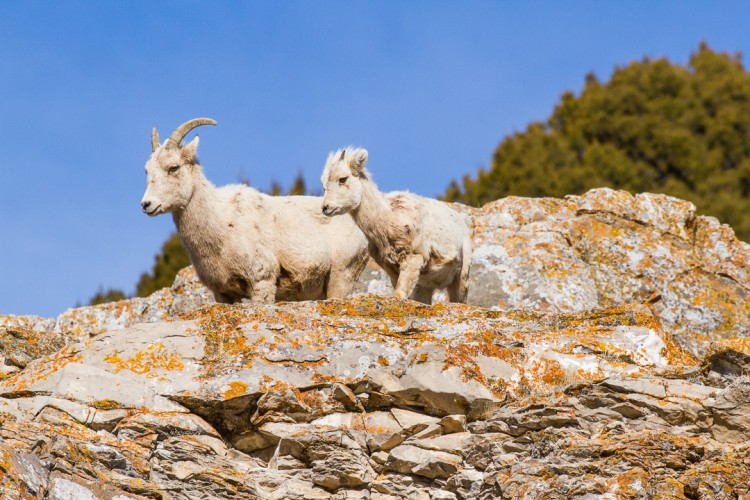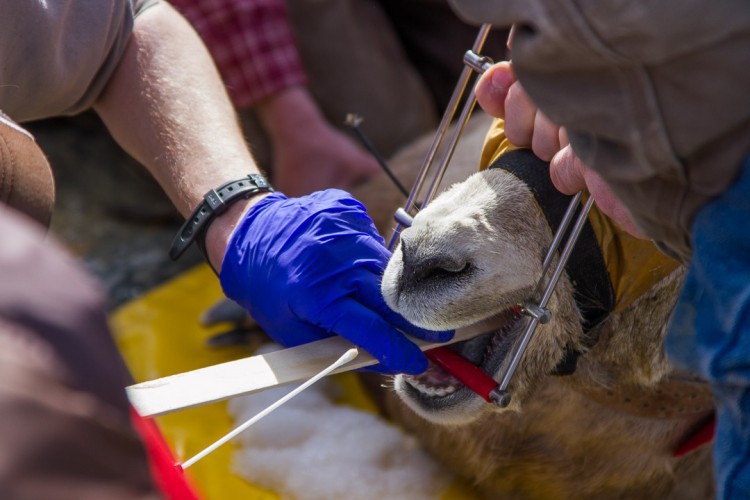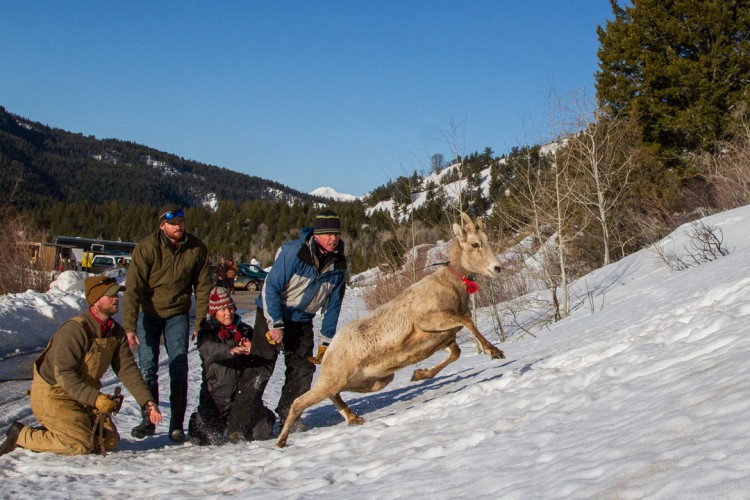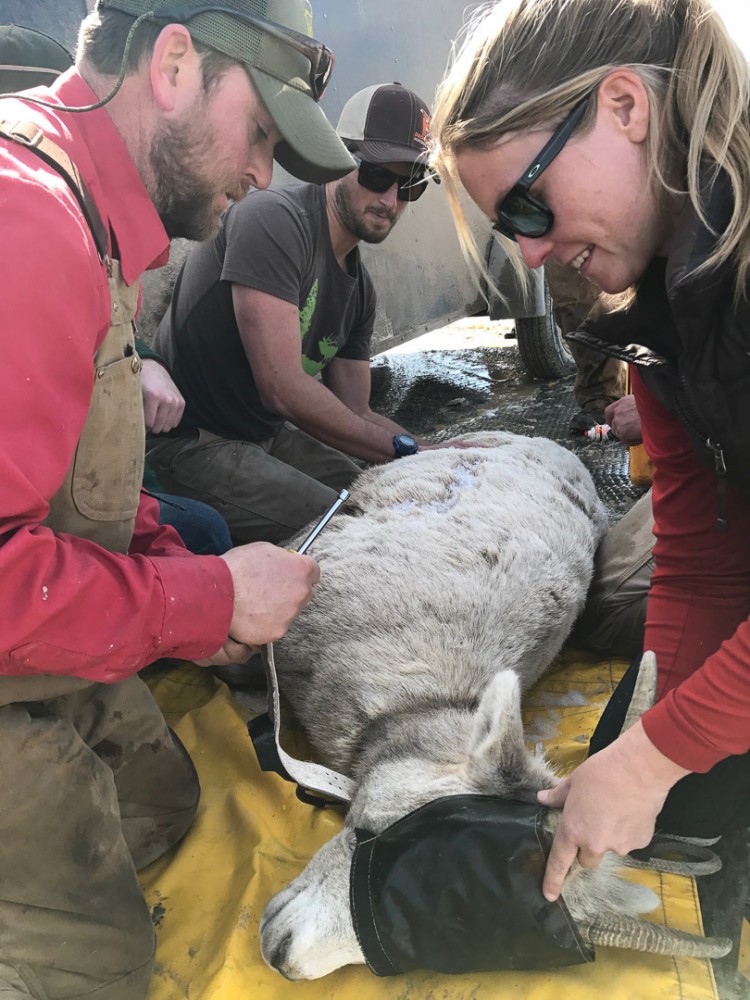Unlocking the Mysteries of Bighorn Health in Jackson Hole


What do helicopters, gps collars and bighorn sheep have in common? They are all an integral part of research being conducted by Wyoming Game and Fish (WYG&F) and the University of Wyoming (UW) in Jackson Hole just outside of Grand Teton National Park!
Earlier in March, Ecotour Adventures naturalists Laura Krusheski and Josh Metten joined scientists for a hands on sheep capture operation just outside Grand Teton National Park. By capturing ewes (females) researchers hope to learn more about winter survival mechanisms such as fat content, pregnancy rates, and disease transmission, key clues to conserving the species.
Life on the Edge
Imagine the life of a bighorn sheep. Your home for much of the year is windy, high elevation terrain near the tops of mountains. Born in rugged terrain atop steep cliffs, lambs can walk within a few hours, quickly becoming used to life on the edge. Forage here, though limited, comes with minimal competition with larger herbivores like elk. Agile in uneven terrain, bighorn are able to evade many predators in this high elevation, windswept environment.

Disease Threatens the Herd
As tough as they are, bighorn in the Gros Ventre herd near Jackson Hole have a critical weakness. Several different pathogens, spread to wild sheep from domestic herds in the past, have contributed to pneumonia outbreaks. Biologists estimate that in 2002 around 50% of the herd, which numbered ~ 500 animals, died of pneumonia. A similar outbreak in 2012 led to a 30% decline. Trying to understand the triggers of these deadly outbreaks, in 2015 biologists began a multi year study of the bighorn herd to understand the cause.
Seeking Answers to a Deadly Mystery
The bighorn die-offs of 2002 and 2012 are not well understood; bacteria in the respiratory system are known to cause pneumonia but are often present in the herd without any manifestation of illness. Biologists believe some other environmental factors must be at play. Despite decades of research on bighorn sheep pneumonia die-offs throughout the West, this complex disease is still poorly understood. Multiple species and strains of bacterial pathogens are likely at play and may interact with bighorn population density, immune system health, or environmental stressors to trigger a population die-off.
In search of the answer to this mystery, WYG&F staff and University of Wyoming researchers met volunteers from Ecotour Adventures, the Wyoming Wild Sheep Foundation, and Wyoming Wildlife Federation in the predawn hours of March 14th before loading into green government trucks to head off towards the fist capture location.
Bighorn sheep winter on protected south facing slopes in the Gros Ventre foothills. The team staged in a nearby parking area while a small blue helicopter flew towards the herd, listening for radio signals coming from females collared back in December.
Helicopter Netgun Capturing of Wild Sheep
As the first light illuminates the parking area we hear the helicopter approaching, carrying two ewes suspended in slings below it. Blindfolded and hobbled with straps around their legs, the bighorn are relatively docile. Avoiding the use of tranquilizers allows bighorn to continue to breath and regulate body temperature normally, making net gunning a much safer option than darting.
The ewes are lowered carefully to the ground. Volunteers race towards the bighorn, carrying them in yellow slings to the processing location. We take nasal ear and tonsil swabs to test for disease pathogens, a blood sample to measure macro-nutrients and blood borne pathogens, and fecal samples for nutrition analysis. Dr. Kevin Monteith takes an ultrasound of the ewe, checking for pregnancy and body fat. The screen reveals the skull of a developing fetus, she’s pregnant!

Working efficiently, we process the each bighorn in about 15 minutes before they are prepared for release. Some are picked back up by the helicopter and shuttled to their capture location, others are released by hand near the processing site. Once the seventh is released we head to our second location.
We relocate to the National Elk Refuge at the southern end of Jackson Hole for the last 7 bighorn captures. The sun is now high in the sky and warm temperatures are causing snow on the valley floor to melt quickly. Sheep Mountain stands 4000’ feet above us to the east; it’s good lambing habitat that many of the ewes we’ve seen today may seek out in the spring to begin raising the next generation.

The future of bighorn sheep in Jackson Hole
Biologists hope this study uncovers some of the population or environmental factors which may be influencing disease outbreaks. If so, management actions may be able stem their frequency, helping the herd persist.

Disease isn’t the only factor which affects the survival of bighorn however. Protecting habitat, especially in winter when bighorn and other animals are most vulnerable is critical. Protecting habitat doesn’t just mean preventing development, it includes protecting wildlife from detrimental human disturbances. That’s why Ecotour Adventures is a proud sponsor of the Don’t Poach the Powder Campaign run by our friends at the Jackson Hole Conservation Alliance, Greater Yellowstone Coalition, and our local land management agencies. Maps of closure areas are available via the campaign, learn more here.
We thank the Wyoming Game and Fish Department, University of Wyoming and others for the opportunity to learn more about these amazing animals, and contribute to their conservation for the future. To learn more visit the Wyoming Cooperative Unit Project Page.
Jackson Hole Ecotour Adventures offers single and multi day trips through Grand Teton and Yellowstone National Parks year round, to join us exploring the Greater Yellowstone Ecosystem visit our website or call 307-690-9533. We hope to see you soon!
Words and Photos by Naturalist Josh Metten













